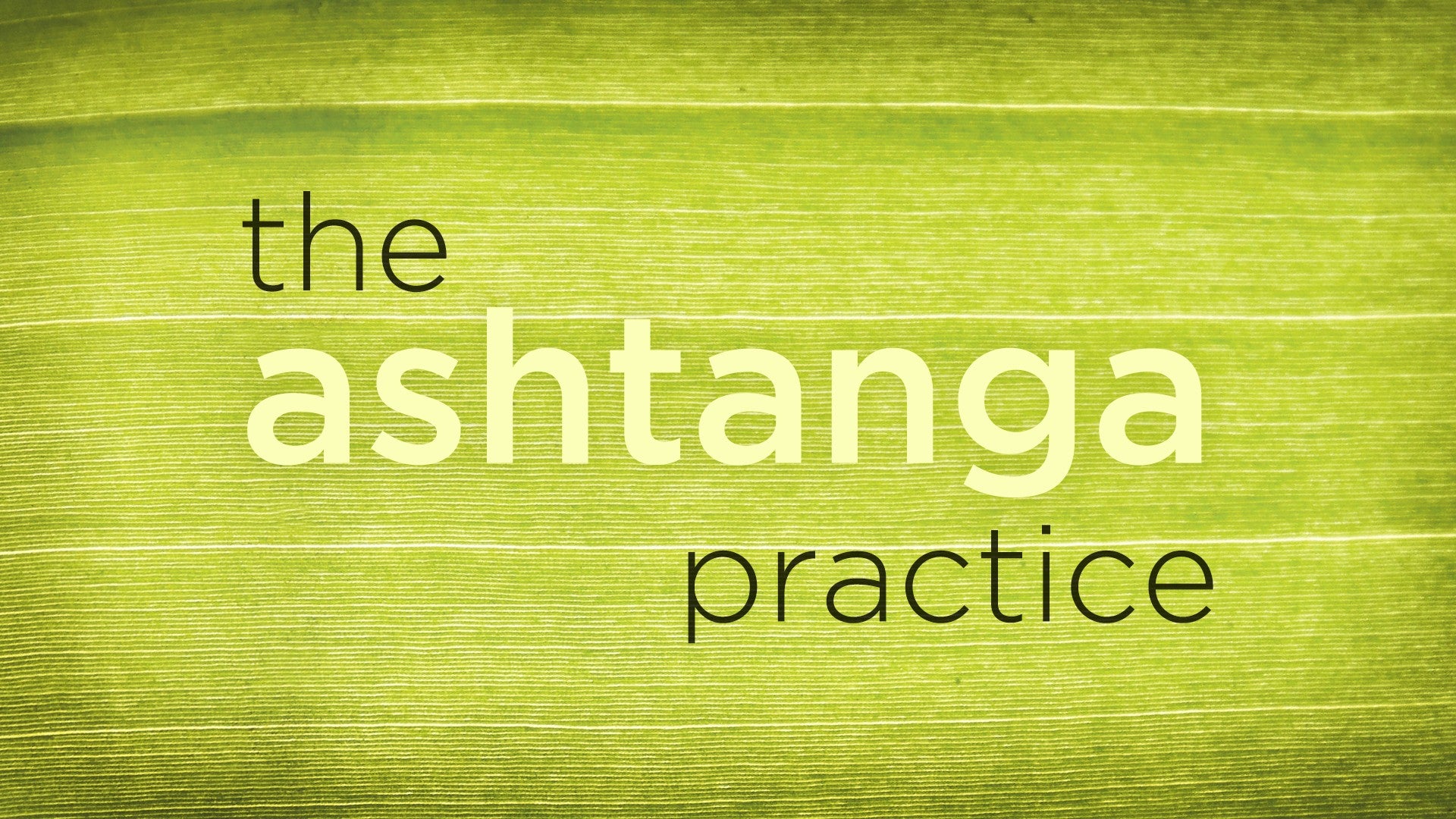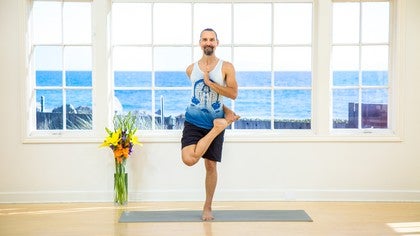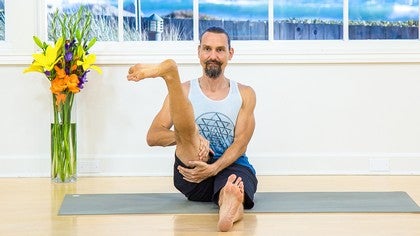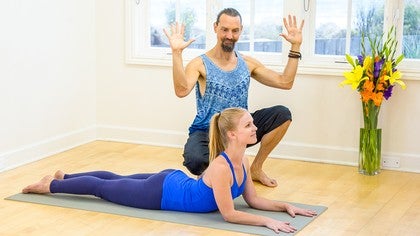Description
Transcript
Read Full Transcript
But wait, don't get scared off because I'm speaking in ancient language here. It might sound like I'm trying to preach some kind of fundamentalist yoga religion. Not the case at all. What I'm hoping to do here is quote one of the essential teachings that we believe Buddha passed on some 2,500 years ago. Again, not fundamentalism, perhaps the opposite of.
What Buddha was saying here was, übho ante anupagama, avoid going down into extremes. Avoid going into extreme views. Avoid going into extreme practices. Avoid the extremes. And from that, when you start avoiding extremes, you begin to cleave a little closer towards the middle way.
And that's what I hope that we can apply in our asana practice, our meditation practice and any of those things. I travel the world teaching yoga. I see lots of people with extreme drishti or extreme breath. And I think, geez, that might work for a little while, but once you know the extreme, hopefully you can cleave back towards the middle. And it's very personal.
What might be too fast for one person might be too slow for another. So in your own practices, you might experiment with what is extreme on one side of the pendulum swing or the other. But eventually, I think with time, you'll settle into a middle way. So coming from your seated position, find yourself on all fours. And I'd like to experiment with some extreme position of the tailbone and the sacrum.
Spreading your fingers wide, finding a four-legged position will experiment with Marjaraasana or the cat pose, cats and cows, as it's commonly known. With an inhale, let the belly drop low, rise the head up, let the eyes journey up between the eyebrows and try to arch the entire spine down towards the mat. And with an exhale, tuck the tailbone under, allowing kyphosis, the rounding up of the spine, and tuck the chin under as well, looking down the tip of the nose, inhaling to bring the lumbar spine into lordosis, sticking the tailbone out, and exhale, tucking the tailbone under. Now, if going through the extremes in any way aggravates or puts pain in the back, don't do it, of course. Only work on your breath, in your comfort zone, and then start to lessen the extremity.
So with this exhale, or your next exhale, go to about 80%. And then with your next inhale, just a little bit less, maybe 60%, exhaling so that you're barely moving the tailbone, just slightly playing in between, a little bit tucked under, and a little bit sticking out, and at your own pace, actually do this and find your middle place where the tailbone's in neutral. Try to remember where that middle place is, and it's probable that your lumbar spine is pretty long, not in lordosis, not in kyphosis, that is not convex or concave, but nice and straight in the lumbar. And from there, tuck the toes under, if they aren't already, about a hip's distance apart. Take a nice, full inhale, and keeping the lumbar spine where it is, keeping the tailbone in neutral, exhale, and begin to lift the bent knees up, lift the hips up, and keep the knees bent so you can keep the lumbar spine in a neutral place.
With the knees bent, you may be able to experiment again with sticking the tailbone out, tucking the tailbone under, and you'll see that you have that range of motion, ideally a great range of comfortable motion in downward dog, and of course, you want to be in your neutral place. A wonderful teacher of Ashtanga, Tim Miller, will call upon us to realize the difference between the extremities of a full downward dog. He will detail what we consider the prana dog, where the tailbone's really sticking out and you're sort of experiencing a deep, deep back bend, this kind of thing popularized by the great teacher Iyengar in the 80s, and an appana dog. If you look at pictures of Krishnamacharya, you might see he's tucked under completely, even rounding the spine, looking up towards the navel. So again, you get these extremities of variations of downward dog, prana extremity, appana extremity, and maybe if you play between your extremities there, you can find a downward dog that's comfortable and in your middle place, your middle way, tailbone neutral, neck neutral, and you have the benefits of both the extremes.
From there, inhale, stepping forward, raising the head up, and then exhale and fold into a forward fold atanasana, and then inhaling, rise all the way up, and exhale right back to your neutral position. Find your samastitihi, and from samastitihi, see if again you can find this axis running through the hips so that you could tilt the tailbone out and see that you can get some movement in the pelvis. Again, in the rare case, having this kind of movement might cause some irritation lower back, don't go to an extreme that's going to hurt you, but explore the movements of the pelvis so that you can find the tailbone pointing down towards the heels, not tucked under, not sticking out, but in a neutral place. Let's see how that works in Trikonasana. Inhale and step your right foot towards the back, your heels in a line with your right toes facing out towards the back of the room, and notice what happened to your tailbone here.
Did you feel that you lost the integrity, the neutrality of the pelvis? Does your tailbone stick out? I'd prefer you to think about your tailbone pointing to your back left heel, keeping Uddiyana Bandha nice and strong as you exhale, reach out over into whatever Trikonasana it is that you prefer, the hand can be wherever, and you might even cheat the left hand down to feel and smooth the tailbone down, so that you feel the tailbone pointing down towards the left heel, Uddiyana Bandha deeply engaged, and with the tailbone in neutral, inhale, come up. Side on the feet and try the other side, exhaling, reaching out over. Notice if you happen to have a tendency to make a big back bend and try to draw in towards the middle, cleave the middle way, hold the middle line, and keep the tailbone pointing towards the right heel, the back heel, so you keep that length happening through the lumbar spine, lengthen your breath.
We exhale a great chance to refine Mula Bandha, Uddiyana Bandha, and inhale, come on up. Exhale back to your Samastitihi, your neutral position there. Let's look at some interesting and more challenging positions. Some people feel Utthita Hasta Panagustasana, the one-legged balance posture, is a really extreme and difficult pose, and your challenge is to even take on more extreme poses while keeping yourself calm and not feeling that you're doing some sort of extreme practice. So Utthita Hasta Panagustasana, left hand on the hips, spread your left toes so that you're really balanced.
If you can lift a straight leg up, go for it, and inhale. If you need to bend the knee to grab the toe, that's fine as well. And then do an exhale. If this is already challenging for you, just stay here or point the toe forward and start to reach the chin over towards the big toe, lengthening the spine over the leg. The standing leg is so important that the left leg stays straight.
And notice the position of the pelvis here. Try to keep the tailbone pointing towards the left heel, the grounded heel. Trini, inhale, come up. Now before you go anywhere else, notice that your tailbone and your right hip can point down towards the left heel. And when you chatwari, exhale and reach the right foot out to the right side.
Keep the tailbone pointing down. Keep the hip at the same level. Don't let that right hip buck up. Externally roll the thigh and you can point through the toe, looking over the left shoulder. You may have to use some restraint and not go to your maximum in this posture to keep the integrity of the pelvis, but it's well worth it.
Keeping the tailbone down, straight leg only. Pancha, inhale, draw the leg to the center and shut, exhale, leaning forward over the leg. Sapta, inhale, head up, point your toe, let it hang in space and hands on the hips. Notice if that hip's risen up and try to, again, externally roll the right thigh to drop the hip, tailbone points towards the bottom heel, standing leg is straight. Exhale and put your foot down and see that your big toes come together right back to Samasthiti.
If when you put the foot down, you notice one foot is turned out to the side, you've done some other kind of modification, try to keep that drawing in of the thighs. Of course, if you're not able to take the pose with straight legs, then you can use a strap or a towel over your left foot, or you can even take the knee. So we'll do the other side. Ashta, inhale, draw the leg up, maybe with straight leg, maybe taking the knee, nava exhale folding forward if it's comfortable, or simply taking it as a standing posture. Conscious of every breath, going through the Bandha and that right leg standing so important.
Dasha, inhale, head up only. Shatakarasha, exhale, rolling the left thigh open, keeping the tailbone pointing down towards the right heel, towards the standing leg, gazing on a still spot, and trying to reflect that stillness internally. Dasha, inhale, draw the foot back to the center. Trayogdasha, exhale, lean forward towards touching. Chaturgdasha, inhale, head up, point your toe, hands to the waist, and balance here.
If you fall down, that's fine, just pick yourself up and try again. Don't worry about how high the leg is, it's fine as long as it's straight. You can have the foot just barely off the ground, but work through Uddhiana, work through the breath, and exhale, bring the foot back to Samastitihi, feet together at the top of the mat. I can inhale, raise your right knee up, and slowly, gently, begin to raise the right foot up. You can take your left hand under the right ankle, right hand under the right calf, and gently, slowly, bring that right knee up.
If at any point the knee starts to feel painful or pinched, modify the posture in whatever way is going to feel okay for the right knee. There'll be plenty of chances for you to do hip opening, so you need not try to go after any kind of grand posture here. If it's comfortable, you can take your exhale and place the right heel up high on the right hip, or even into the abdomen, and still, if it's comfortable, you might have the right knee gently dropping towards the mat. Again, only doing this if it's comfortable. If you know the full posture, you're welcome to go for it.
The right hand might come around behind you, binding on the left arm. You may even be able to reach the right hand down and take the right foot. You might exhale and fold forward if you like, or again, just take the posture as a standing pose here, breathing comfortably. If you have gone forward into the full posture, the way to come out is trini, inhale, head up only. Inhale here, bend the knee if you like, and then chatwadi, inhale, come all the way up, keeping the left hand empty, so just the right hand is holding, and then pancha, exhale, release your leg.
I'd like to straighten it in space, and then bring the foot back to samastitihi. All right, so second side then, shot, inhale, honor and respect the differences in the sides. It's unlikely both hips are exactly the same. One side might be more open, one side might need more modification. You may just be holding your knee and your foot up in space here, dorsiflexing the foot, and keeping length through the spine.
Again, any pinching, especially on the inside of the knee, would mean you should take a different modification of the posture. If you have gone forward, ashta, inhale, lift your head straight up, exhale here, nava, inhale, come up, hand is empty, and exhale, back to samastitihi. So after the one-legged balance postures, then the vinyasas will begin. Vinyasas are like mini sun salutations. We're going to stitch the poses together to finish the standing sequence with.
We'll start in samastitihi. The name of the pose is utkatasana, but we enter it through a sun salutation A. So with the straight legs, ekimi, inhale, arms up, dweh, exhale, folding forward, following the breath to the mat, trini, inhale, the buoyant chest lifting forward, begin your exhale here, chattwari, jump back, chattaranga, pancha, inhale, upward facing dog, shat, exhale, downward facing dog, find down dog, exhale completely, sapta, inhale, jump or hop both feet forward, keeping the knees bent, plant the feet, squeeze the knees together and raise the arms up, looking onto the thumbs. One, we've entered the state of asana here, the posture that's held and balanced, two. How much should the hips drop? Three, we'll find a middle place between too low and too high, four, drawing the knees back slightly, working in your middle place, in your middle way, and five, exhale, keeping the knees bent, make sure your knees are bent, chest goes towards the thighs, hands can come down in front of the feet, knees stay bent here, ashta, inhale, leaning forward, pushing into the hands, lifting one heel or both heels up off the mat, and nava, chattwari, jumping back to chaturanga, dasa, inhale, upward facing, vakarsa, exhale, downward facing dog, virabhadrasna A, sapta, inhale, plant the left heel deeply, the right foot far forward, heels in a line, the right knee bent, see your thumbs, and breathe.
One, keeping the thumbs lifting, two, the shoulders rolling away from the ears, three, still udana bandha drawing the abdomen in, four, five, inhale, straighten the right leg, pivot on the feet to change the side, and ashta, exhale, bend your left knee, one, the drishti still up at the thumbs, two, three, keeping the hips squaring towards the back of the room, four, the shoulders absolutely square there, and keeping the left knee bent, five, b, nava, inhale, keeping the left knee bent, peel out the hands, the shoulders, and the hips, indivirabhadrasna b, one, gazing out over your left hand, two, keeping the left knee deeply bent, sitting down, sinking into the posture, three, and again, not letting the tailbone stick out and the chest flare out, dropping the tailbone down to a neutral position, four, five, inhale, straighten the left leg, pivot on the heels to change side, and ashta, exhale, bend your right knee, indivirabhadrasna b, one, notice if that right knee starts to creep in, make sure that it's staying out over the ankle, two, keeping that left thigh rolling open externally, three, four, lengthening the spine up through the back top of the head, and the tailbone down towards the mat, five, exhale, plant the hands down, you can step the right foot halfway back, ekadasha, inhale, draw the straightened left leg up, right foot comes up to meet it, and dvadasa, exhale, jump back, chaturanga, triyugdasa, inhale, upward facing, chaturgdasa, exhale, downward facing dog, we'll come to a sitting posture here, sapta, inhale, jump through, straight legs sit down in dandasana, and then release your feet, draw your hands up, and find yourself in any comfortable seated posture, sitting however it's comfortable for you, again no extreme sitting postures but one where you can come to rest in your center, finding your middle way, and take note of how you feel after any practice, after an extended asana practice, sometimes you might feel like you're incredibly tired, or incredibly dry, or thirsty, or very hungry, notice if those extremes come up, maybe you're extremely sad, or extremely happy, and remember that our practice shouldn't be leaving us, or leading us towards extreme states, but instead our practice might lead us towards an internal balance, one which we are able to observe ourselves more clearly, observe truth more clearly, so just find yourself resting on breath, noticing how you feel right now, may this practice and all practices guide you back to your center towards the light so that you may see more clearly, thank you.
The Ashtanga Practice: Dylan Bernstein
Comments

You need to be a subscriber to post a comment.
Please Log In or Create an Account to start your free trial.







